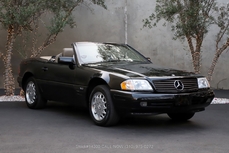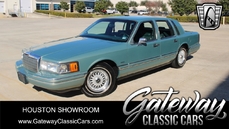Mercedes-Benz 600SL r129 6.0L V12 1998
General description :
Mileage : 36130
Interior Color : Tan
Exterior Color : Black
VIN : WDBFA76F2WF164611
Transmission Description : 5 Speed Automatic
Doors : 2
Description : Gateway Classic Cars Houston Showroom is excited to present this powerful black 1998 Mercedes-Benz SL600. From 1993-2002, Mercedes-Benz produced just a little over 11,000 of these (former) supercars, which were typically priced close to $130K. Today, many buyers who remember wishing they could have one back then, are making their moves on these gorgeous V12-engined powerhouses. Still a potent powerplant, the 389HP V12, with its prodigious 420 LB-FT torque, can hustle these cars down the interstate at their 155 MPH "governed" limit for as long as the tank of fuel lasts, or traffic density allows. Safety was of paramount importance at Mercedes-Benz (but then it always is) in the design of these cars: in addition to the standard Supplemental Restraint System features (airbags, locking seatbelts, etc.), these R129 Benzes have an automatic roll bar that deploys automatically within .3 seconds in the event of a rollover, along with a seat design that incorporates 5-piece frames made from a magnesium alloy, which provides enhanced protection in side impacts. This SL600 is equipped to the hilt, with nearly every power option that could be added to a vehicle in 1998, including Power Anti-lock Disc Brakes at all 4 corners, Power Locks, Power Mirrors, Power Heated Seats, Power Steering, and Power Windows. It also has an AM/FM/Cassette head unit, along with CD Changer, Cruise Control, automatic HVAC climate control system, performance radial tires on aluminum wheels, tilt/telescoping steering column, and a Parchment leather interior (which looks virtually unused), and gorgeous wood trim. About the only thing that needs to be addressed is the hydraulic hardtop release: even though the hydraulic fluid is at the recommended level and the motors can be heard working, for some reason, the top isn't releasing...so, for now, it's a coupe; but with a little TLC, no doubt this glorious high-speed roadster can be brought back to 100% of its functionality! Regardless of operating mode (coupe or roadster), this is a very attractive car in great condition. Don't miss out on one of Mercedes' premier road cars of the 1990's. Give us a call or email our Houston showroom - we'll be happy to assist you in putting this in your collection!
1998 Mercedes-Benz 600SL r129 6.0L V12 is listed for sale on ClassicDigest in Houston by Gateway Classic Cars - Houston for $21000.
Car Facts
Car type : Car Make : Mercedes-Benz Model : 600SL r129 Model Version : 6.0L V12 Engine size : 6.0 Model Year : 1998 Location : Houston Vehicle Registration : Undefined
21000 $
Seller Information
Gateway Classic Cars - Houston
Gateway Classic Cars - Houston
832-210-3324
Gateway Classic Cars - Houston
832-210-3324
People who viewed this Mercedes-Benz 600SL r129 also viewed similar Mercedes-Benz listed at ClassicDigest
Other cars listed for sale by this dealer
About Mercedes-Benz
In the annals of automotive history, the journey of Mercedes-Benz is a tale that unfolds with the ingenuity of its founding pioneers. In the year 1886, Karl Benz crafted the Benz Patent Motorwagen, a creation that would go down in history as the world's inaugural automobile. Unbeknownst to him, this moment marked the genesis of what would evolve into the most illustrious premium car manufacturer globally. The financial underpinning of this pioneering venture, interestingly, was provided by Karl Benz's wife, Bertha Benz, demonstrating a remarkable partnership that would set the tone for Mercedes-Benz's legacy.A parallel narrative emerged not far away, as Daimler-Motoren-Gesellschaft, founded by Gottlieb Daimler and Wilhelm Maybach, entered the scene. In 1901, they unveiled their automobile under the now-famous moniker "Mercedes," meaning "godsend" in Spanish. This name was bestowed upon the car at the behest of Emil Jellinek's daughter, the distributor for Daimler-Motoren-Gesellschaft. The wheels of innovation were set in motion.
Fast forward to 1926, a pivotal year that witnessed the merger of Daimler with Benz & Cie., culminating in the birth of Daimler-Benz. The amalgamation saw the adoption of "Mercedes-Benz" as the distinguished trademark for their automobiles, fusing the legacies of two visionary entities into one.
Contrary to perceptions of conservatism, the trajectory of Daimler-Benz unfolds as a chronicle of industry firsts. From the introduction of the honeycomb radiator to the float carburetor, and the pioneering implementation of four-wheel brakes in 1924, Daimler-Benz consistently pushed the boundaries of automotive innovation. The diesel-powered Mercedes-Benz 260 D in 1936 marked the inception of diesel engines in passenger cars. The iconic Mercedes-Benz 300SL Gullwing made history as the first car with direct fuel injection, albeit the Gutbrod's tiny 2-stroke engine can claim precedence.
Safety innovations became a hallmark, with Béla Barényi's patented safety cell design in the "Ponton"-models in 1951, featuring front and rear crumple zones. The W116 450SEL 6.9 saw the introduction of the Anti-Lock Brake system (ABS), another pioneering safety feature. From the first production airbags and beyond, the legacy of "firsts" continued to be etched into the fabric of Daimler-Benz.
Over its centennial journey, Mercedes-Benz has not merely produced cars but has sculpted automotive icons. The SSKL, 710 SSK Trossi Roadster, 770K Grosser, 540K Spezial Roadster, 300SL Gullwing, w100 600 Pullman, w111 280SE 3.5 Flachkühler, w113 230SL Pagoda, w109 300 SEL 6.3, and w201 2.3-16 Cosworth stand testament to the brand's commitment to engineering excellence.
The roaring Silver Arrows, or "Silberpfeile," including the W 25, W 125, W154, W165, and W196, created a legacy of dominance on the racetrack. These machines were not merely cars; they were expressions of precision, speed, and an indomitable spirit that left their competitors in the dust.
As Mercedes-Benz marches into the future, it does so not just as an automaker but as a custodian of a legacy, a torchbearer of innovation, and a beacon of automotive excellence. The road ahead is sure to witness the continued fusion of cutting-edge technology, timeless design, and an unwavering commitment to setting new standards in the world of automobiles.
One luminary figure who left an indelible mark was Béla Barényi, often heralded as the "father of passive safety" for his pioneering work in safety engineering. His patented safety cell design, featuring front and rear crumple zones, became a hallmark of Mercedes-Benz's commitment to occupant safety, setting new standards that reverberated throughout the automotive world.
Moving through the chronicles, the collaborative genius of Wilhelm Maybach, alongside Gottlieb Daimler, laid the foundation for Daimler-Motoren-Gesellschaft. Their innovations not only birthed the first Mercedes but established a culture of relentless pursuit of technological excellence that remains integral to Mercedes-Benz's DNA.
In the post-merger era of 1926, Ferdinand Porsche emerged as a prominent figure within Mercedes-Benz. His work on the Mercedes-Benz S-Type, a supercharged race car, garnered acclaim and set the stage for a legacy that extended far beyond the marque. Porsche's impact would later extend to his eponymous company, but his influence at Mercedes-Benz during those formative years was pivotal.
As the 20th century progressed, the legendary Rudolf Uhlenhaut emerged as a key figure. Uhlenhaut, an accomplished engineer and the driving force behind the iconic Silver Arrows, played a crucial role in Mercedes-Benz's dominance in motorsports. His engineering prowess and attention to detail were instrumental in creating some of the most formidable racing cars of the era.
In the latter half of the century, figures like Bruno Sacco, the head of design at Mercedes-Benz from 1975 to 1999, left an indelible imprint on the brand's aesthetic identity. Sacco's design philosophy, characterized by clean lines and timeless elegance, shaped iconic models like the W126 S-Class and the W201 190E, solidifying Mercedes-Benz's reputation for luxury and sophistication.
The narrative would be incomplete without acknowledging the contributions of engineers like Hans Scherenberg, whose leadership in the 1970s ushered in a new era of technological innovation at Mercedes-Benz. Scherenberg's tenure saw the development of groundbreaking technologies, including the Anti-Lock Brake system (ABS) and the introduction of airbags in production cars.























